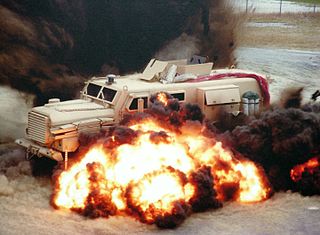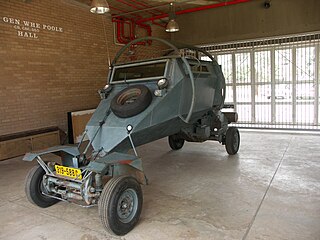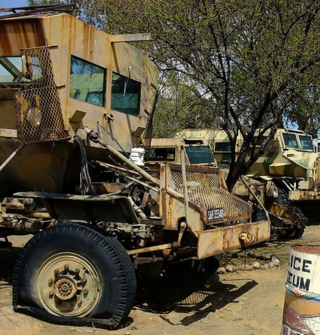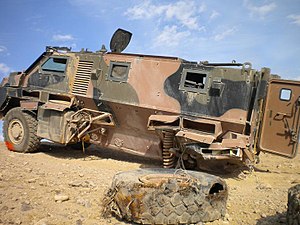
The Casspir is a Mine-resistant ambush protected vehicle that has been in use in South Africa since the 1980s. It is a four-wheeled, four-wheel drive vehicle, used for transport of troops. It can hold a crew of two, plus 12 additional soldiers and associated equipment. The Casspir was unique in design when launched, providing for passive mine defence. The main armoured steel body of the vehicle is raised high above the ground, so when a mine is detonated, the explosion is less likely to damage the crew compartment and kill the occupants. The cross-section of the hull is V-shaped, directing the force of the explosion outwards, further protecting the occupants.

The RG-31 Nyala is a 4×4 multi-purpose mine-resistant ambush protected infantry mobility vehicle manufactured in South Africa by Land Systems OMC, located in Benoni, South Africa and in Turkey by FNSS Defence Systems. It is based on the Mamba APC of TFM Industries.

The Buffel is an infantry mobility vehicle used by the South African Defence Force during the South African Border War. The Buffel was also used as an armoured fighting vehicle and proved itself in this role. It replaced the older Bedford RL-based Hippo APC and itself was replaced by the Mamba from 1995 in South Africa, but remains in use elsewhere, notably Sri Lanka.
Land Systems OMC is a South African company that produces a range of armoured vehicles which have been successfully exported and are in service with, amongst others, the U.S., Canadian and South African militaries. It is a division of Denel SOC LTD, located in Benoni, Gauteng.

The Buffalo is a wheeled mine resistant ambush protected (MRAP) armored military vehicle built by Force Protection, Inc., a division of General Dynamics. It is the largest vehicle in Force Protection's line-up, followed by the Cougar MRAP and the Ocelot light protected patrol vehicle (LPPV).

The Cougar is a mine-resistant ambush-protected (MRAP) and infantry mobility vehicle structured to be resistant to landmines and improvised munitions.
Force Protection, Inc. was a manufacturer of ballistic- and blast-protected vehicles from the United States which have been used in Iraq, Afghanistan, Kosovo and other hot spots around the world. The company was acquired by General Dynamics in 2011.

The RG-33 is a mine-resistant light armored vehicle initially designed by BAE Systems Land Systems South Africa, a South African subsidiary of BAE Systems. BAE Systems in the US extensively modified it with additional protection, new powertrain, and suspension systems. It was built in a number of locations including York, Pennsylvania. It was one of several vehicles being fielded by the US Armed Forces in Iraq under the MRAP program.

An infantry mobility vehicle (IMV) is a wheeled armored personnel carrier (APC) serving as a military patrol, reconnaissance or security vehicle. Examples include the ATF Dingo, Iveco LMV, Oshkosh M-ATV, AMZ Dzik, AMZ Tur, Mungo ESK, and Bushmaster IMV. This term also applies to those vehicles fielded as part of the MRAP program.

The REVA Armoured Personnel Carrier (APC) is a mine-protected vehicle. It is produced by Integrated Convoy Protection. The vehicle’s V-shaped hull offers protection against land mines and Improvised Explosive Devices (IED)s. The vehicle has space for at least 10 passengers. Ten firing ports are also available. Two light machine guns can be used and cover a 360-degree on roller bearing turret hatches.

Mine-Resistant Ambush Protected is a term for United States military light tactical vehicles produced as part of the MRAP program that are designed specifically to withstand improvised explosive device (IED) attacks and ambushes. The United States Department of Defense MRAP program began in 2007 as a response to the increased threat of IEDs during the Iraq War. From 2007 until 2012, the MRAP program deployed more than 12,000 vehicles in the Iraq War and War in Afghanistan.

The GFF4, previously KMW Grizzly, is a medium weight MRAP armored personnel carrier, developed by Krauss-Maffei Wegmann (KMW), designed for operation with the German Army based on the 6x6 Trakker chassis from Iveco adapted to meet the needs of the German Army. It is being developed under the direction of the German Ministry of Defence Federal Office of Defense Technology and Procurement. The first vehicle will be delivered as early as November 2007.

The Unicorn is a MRAP used by the Sri Lankan military based on the Buffel, which is made by the Sri Lanka Electrical and Mechanical Engineers.

The Leopard Security Vehicle is an unusual land-mine protected APC used by the Rhodesian Government and civilian population during the 1964-1979 Rhodesian Bush War. It offered basic but necessary protection against mine attack through the use of a V-hull.

The Force Protection Ocelot is a British armoured vehicle that replaced the United Kingdom's Snatch Land Rover with British forces. It received the service name Foxhound, in line with the canine names given to other wheeled armored vehicles in current British use such as Mastiff, Wolfhound, and Ridgeback, which are all variants of the Cougar.
The Mahindra Mine Protected Vehicle-I (MPV-I), is an Indian MRAP-type armored personnel carrier manufactured by Defense Land Systems, a joint-venture of Mahindra & Mahindra Limited and BAE Systems, the first vehicle made under the venture. It is an improved Casspir variant built under licence.

The Hippo is a South African armoured personnel carrier. Specially designed to be mine resistant, it can carry ten infantrymen and a crew of two. The vehicle's remote-operated turret mounts dual 7.62mm machine guns, but like other improvised fighting vehicles, it is only lightly protected against ballistic threats.

The Wer'wolf MK2 is a Namibian designed and built military vehicle that offers protection against small arms fire and land mines. The vehicle uses a MAN chassis, axles and engine. The Wer'Wolf MK2 is a modular vehicle. It is built with a crew compartment that seats three people plus a driver and a rear flatbed configuration. The flat bed configuration allows for different modules to be fitted. It is suited for rough terrain, in APC configuration the Wer'Wolf MK2 can carry up to 10 passengers plus the driver. Designed and built in 1998 it was the first Mine Protected Vehicle manufactured by Windhoeker Maschinenfabrik after it was bought by Government of Namibia.

The Ordnance Factory Board Mine Protected Vehicle is a Mine-Resistant Ambush Protected-type vehicle used by the Indian Army and the Central Reserve Police Force as an armored personnel carrier to transport personnel with protections from explosives and small arms fire. The MPV’s construction was based on the Casspir Mk II, which India used in the 1990s.
The Gila APC is a mine protected vehicle from South Africa developed by private investors and manufactured by IVEMA and similar to the more popular Casspir.























